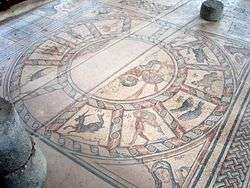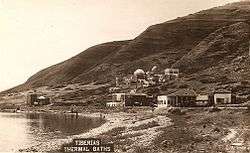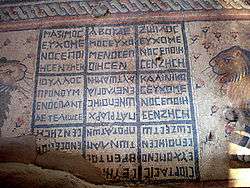Hamat Tiberias
Hamat Tiberias is an ancient archaeological site and an Israeli national park known as Hamat Tverya National Park which is located on the Tiberias-Zemach road that runs along the shore of the Sea of Galilee to Tiberias.

Name
Hammath or Hamma is the Hebrew and Semitic word for "hot spring." The Hebrew possessive plural is hamei-. It is adjacent to the ancient city of Tiberias, which was established in the first century CE and is now called ""Tveriya," thus the springs and the resort are called Hamei Tveriya. Since several places bore the name "Hammath", the distinction was made here by adding Tiberias/Tveriya to the name. Spelling vary for both parts of the Hebrew name. The Arabic name uses the cognate word: Al-Hammam.
History

The 17 springs of Hamat Tiberias have been known since antiquity for their curative properties. According to the Jerusalem Talmud, a village once rested upon the site and was distinct from Tiberias. The site was rediscovered in 1920 when the Tiberias-Samakh road was being constructed.
The Hamei Tveriya natural hot springs are located on the grounds of the park. According to the sages of the Talmud, the springs were heated when they streamed past the entrance of Hell.[1] Archaeologists have concluded it was built on the ruins of the biblical city of Hammath. (Joshua 19:350 However the finds of the excavations are limited to the 1st-8th centuries CE.[2] The small town eventually merged with Tiberias.
Synagogue

The Hammat Tiberias Synagogue is an ancient synagogue on the outskirts of Tiberias, located near the hot springs just south of the city. The synagogue dates to 286 and 337 CE, when Tiberias was the seat of the Sanhedrin. Two synagogue sites have been excavated at Hammat Tiberias. The first, uncovered in 1921 by Nachum Slouschz who was working under the sponsorship of the Jewish Palestine Exploration Society, was a watershed event in the history of Israeli archaeology as the first archaeological dig conducted under Jewish auspices.[3] A limestone menorah was uncovered there which is now on display at the Israel Museum. The mosaic floor is made up of three panels featuring: inscriptions and dedications; the zodiac panel, including Helios the sun god and four women symbolizing the four seasons of nature; while the upper panel depicts the Temple of Jerusalem plus the primary symbols of Judaism, the menorah candelabra, shofar horn, arbaa-minim plants, and a mahta shovel.[4]
The second synagogue site, excavated by Moshe Dothan, is noted for its elaborate mosaic floor. The synagogue, dated to the last half of the fourth century C.E., was named after an inscription that reads, in Greek, "Severus the pupil of the most illustrious patriarchs," an apparent reference to the leaders of the Jewish community.
In the center of one large mosaic is the Sun god, Helios, sitting in his chariot holding the celestial sphere and a whip. Nine of the 12 signs of the zodiac survived intact. Another panel shows a Torah ark flanked by two the seven-branched menorahs and other Jewish ritual objects.
Phuttu
References
- Zev Vilnay (June 1978). Legends of Galilee, Jordan, and Sinai. Jewish Publication Society of America. p. 168. ISBN 978-0-8276-0106-2.
- Gordon, Douglas L (1997). "HAMMATH TIBERIAS". The Oxford Encyclopedia of Archaeology in the Near East. p. 470. ISBN 0195112156.
- S. Fine Art and Judaism in the Greco-Roman World: Toward a new Jewish Archaeology (Cambridge, 2005), 22-7
- Hamat Tiberias National Park, An opulent synagogue and ancient medical baths
M.T. Olszewski, The Historical Background of the Zodiac Mosaic Calendar in the Lower Synagogue at Hammath-Tiberias, see: https://www.academia.edu/1760071
External links
- Hamat Tiberias National Park at the Israeli Parks Authority site.